Transmission Quality Classification with Use of Fusion of Neural Network and Genetic Algorithm in Pay&Require Multi-Agent Managed Network
Abstract
1. Introduction
- Data used in the learning process obtained thanks to the empirical feelings of network users;
- Classification of transmission quality using machine learning;
- An algorithm, which is a fusion of a neural network (NN) and a genetic algorithm (GA) in combination with preprocessing and cross-validation was proposed.
2. Related Work
- Monitoring—one or more instance of such agent appears on every router (physical layer). The task of this agent is to monitor the parameters of individual links. In the first studies, static translation tables of parameters describing the quality (delay, bandwidth, packet loss ratio and jitter) were used—the ranges of individual parameters and the final evaluation of the quality of transmission via a given link were determined. Unfortunately, this solution turned out to be unreliable, so it was decided to use other techniques—first single classifiers and ensemble learning, and in the current work, fusion of NN and GA.
- Reconfiguration—in a situation where the current transmission parameters do not meet the customer’s requirements, this agent performs the reconfiguration process. The reconfiguration process consists in verifying the quality of transmission through individual paths and selecting the paths in line with customer requirements. Then, the reconfiguration of physical devices is carried out—control commands are sent that change entries in the routing table.
- Trader—this agent is responsible for carrying out the data transmission quality purchasing process. In P&R, transmission quality is a good that can be purchased for a certain price (e.g., using auctions).
3. Materials and Methods
3.1. Assumptions
- This article proposes a new quality determination algorithm based on the fusion of a NN and GA.
- The samples used at the training stage were obtained from users based on their empirical feelings regarding the quality of the data transmission.
- Thanks to Pay and Require, it is possible to provide data transmission services at the level expected by the customer and this quality is guaranteed.
3.2. Dataset
3.3. Methods
- SEN—sensitivity (overall accuracy),
- TP—True Positives,
- FN—False Negatives.
- Read input data: The input data consisted of 100 samples. One sample is constructed of delay (D), bandwidth (B), packet loss ratio (PLR), jitter (J) values and the quality (Q) label.
- Preprocessing: One rescaling algorithm was used, i.e., min–max scaler. Thanks to the use of this algorithm, data was obtained in a specific range of values. The presented method uses the scaling to values in the range of 0–1.
- Cross validation: 10-fold stratified cross validation was used. This means that the whole samples set was divided into ten subsets. Nine of these subsets were used at the stage of NN learning and optimizing parameters with the use of a GA. One subset was used to verify accuracy. All studies were performed on test data.
- Classification: For classification purposes, the multilayer perceptron (MLP) was used.
- Learning: To optimize the parameters, GA was used.
- n—number of the test sets,
- zi—expected answer for sample i,
- yi—perceptron answer for sample i.
- Selection of the NN architecture through evolutionary computing.
- Finding the appropriate set of weights of the NN using GA.
- Combination of the approaches from (1) and (2) [57].
3.4. Previous Research
4. Results
- The number of individuals [100, 200, 300, 400, 500, 1000, 2000, 3000];
- Number of epochs [100, 200, 300, 400, 500, 1000, 2000, 3000];
- Type of crossover—two-point, uniform, arithmetic;
- Type of mutation—one, two, three points.
- Number of individuals—300;
- Number of epochs—2000;
- Uniform crossover;
- Two-point mutation;
- Elitism—one best individual goes to the next epoch;
- Tournament selection with tournament size 3.
5. Conclusions
- The use of a method combining NN and a GA for the classification of the quality of the data transmission in the P&R network;
- Comparison of the results obtained with the method proposed in this article with the results obtained for previous studies, i.e., the use of single classifiers and ensemble learning;
- The method of obtaining samples for the purpose of ML training obtained using QoE;
- The P&R network, the main assumption of which is to provide quality of the data transmission services at the level expected by the customer.
- The number of samples used in the learning process was 100. This number seems to be sufficient, but using more samples should be considered. A larger number of samples would allow the preparation of a better model—more resistant to overfitting.
- The reliability of the samples turned out to be very important, because the overall classification accuracy depends on the quality of the samples.
- The result obtained in the presented research is satisfactory (SEN = 95%), but it seems possible to get an even better result.
Author Contributions
Funding
Institutional Review Board Statement
Informed Consent Statement
Data Availability Statement
Conflicts of Interest
References
- Definitions of Terms Related to Quality of Service. 2008. Available online: https://www.itu.int/rec/T-REC-E.800-200809-I (accessed on 11 June 2021).
- Perez, J.A.; Zarate, V.H.; Cebrera, C. A Network and Data Link Layer QoS Model to Improve Traffic Performance. In International Conference on Embedded and Ubiquitous Computing; Springer: Berlin/Heidelberg, Germany, 2006. [Google Scholar]
- Perez, J.; Silva, V.; Cabrera, C.; Janecek, J. A Network and Data Link Layer Infrastructure Design to Improve QoS for Real Time Collaborative Systems. In Proceedings of the Advanced Int’l Conference on Telecommunications and Int’l Conference on Internet and Web Applications and Services (AICT-ICIW’06), Guadeloupe, French, 19–25 February 2006; p. 19. [Google Scholar]
- Książek, W.; Abdar, M.; Acharya, R.; Pławiak, P. A novel machine learning approach for early detection of hepatocellular carcinoma patients. Cogn. Syst. Res. 2019, 54, 116–127. [Google Scholar] [CrossRef]
- Książek, W.; Hammad, M.; Pławiak, P.; Acharya, R.; Tadeusiewicz, R. Development of novel ensemble model using stacking learning and evolutionary computation techniques for automated hepatocellular carcinoma detection. Biocybern. Biomed. Eng. 2020, 40, 1512–1524. [Google Scholar] [CrossRef]
- Abdar, M.; Książek, W.; Acharya, R.; Tan, R.S.; Makarenkov, V.; Pławiak, P. A new machine learning technique for an accurate diagnosis of coronary artery disease. Comput. Methods Programs Biomed. 2019, 179, 104992. [Google Scholar] [CrossRef]
- Arabasadi, Z.; Alizadehsani, R.; Roshanzamir, M.; Moosaei, H.; Yarifard, A.A. Computer aided decision making for heart disease detection using hybrid neural network-Genetic algorithm. Comput. Methods Programs Biomed. 2017, 141, 19–26. [Google Scholar] [CrossRef]
- Pławiak, P.; Maziarz, W. Classification of tea specimens using novel hybrid artificial intelligence methods. Sens. Actuators B Chem. 2014, 192, 117–125. [Google Scholar] [CrossRef]
- Pławiak, P.; Tadeusiewicz, R. Approximation of phenol concentration using novel hybrid computational intelligence methods. Appl. Math. Comput. Sci. 2014, 24, 165–181. [Google Scholar]
- Nguyen, T.; Armitage, G. A survey of techniques for internet traffic classification using machine learning. IEEE Commun. Surv. Tutor. 2008, 10, 56–76. [Google Scholar] [CrossRef]
- Dong, S.; Zhou, D.; Ding, W. The Study of Network Traffic Identification Based on Machine Learning Algorithm. In Proceedings of the 2012 Fourth International Conference on Computational Intelligence and Communication Networks, Mathura, India, 3–5 November 2012; pp. 205–208. [Google Scholar]
- Żelasko, D. Simulation of transmission quality classification in Pay&Require multi-agent managed network by means of Machine Learning techniques. Simul. Model. Pract. Theory 2020, 103, 102106. [Google Scholar]
- Żelasko, D.; Pławiak, P.; Kołodziej, J. Machine learning techniques for transmission parameters classification in multi-agent managed network. In Proceedings of the 2020 20th IEEE/ACM International Symposium on Cluster, Cloud and Internet Computing (CCGRID), Melbourne, VIC, Australia, 11–14 May 2020; pp. 699–707. [Google Scholar]
- Żelasko, D.; Pławiak, P. Ensemble learning techniques for transmission quality classification in a Pay&Require multi-layer network. Int. J. Appl. Math. Comput. Sci. 2021, 31, 135–153. [Google Scholar]
- Tadeusiewicz, R. Neural networks as a tool for modeling of biological systems. Bio-Algorithms Med-Syst. 2015, 11, 135–144. [Google Scholar] [CrossRef]
- Szaleniec, M.; Tadeusiewicz, R.; Witko, M. How to select an optimal neural model of chemical reactivity? Neurocomputing 2008, 72, 241–256. [Google Scholar] [CrossRef]
- Holland, J.H. Adaptation in Natural and Artificial Systems: An Introductory Analysis with Applications to Biology, Control, and Artificial Intelligence; U Michigan Press: Ann Arbor, MI, USA, 1975. [Google Scholar]
- Whitley, D. Genetic algorithms and neural networks. Genet. Algorithms Eng. Comput. Sci. 1995, 3, 203–216. [Google Scholar]
- Ecer, F.; Ardabili, S.; Band, S.S.; Mosavi, A. Training Multilayer Perceptron with Genetic Algorithms and Particle Swarm Optimization for Modeling Stock Price Index Prediction. Entropy 2020, 22, 1239. [Google Scholar] [CrossRef]
- Alfred, R. A genetic-based backpropagation neural network for forecasting in time-series data. In Proceedings of the 2015 International Conference on Science in Information Technology (ICSITech), Yogyakarta, Indonesia, 27–28 October 2015; pp. 158–163. [Google Scholar]
- Meng, X. Weather Forecast Based on Improved Genetic Algorithm and Neural Network. In Proceedings of the International Conference on Information Engineering and Applications (IEA), London, UK, 28 March 2013; pp. 833–838. [Google Scholar]
- Software-Defined Networking (SDN): Layers and Architecture Terminology. 2015. Available online: https://tools.ietf.org/html/rfc7426 (accessed on 11 June 2021).
- Kreutz, D.; Ramos, F.M.V.; Veríssimo, P.E.; Rothenberg, C.E.; Azodolmolky, S.; Uhlig, S. Software-Defined Networking: A Comprehensive Survey. Proc. IEEE 2015, 103, 14–76. [Google Scholar] [CrossRef]
- Shirmarz, A.; Ghaffari, A. Performance issues and solutions in SDN-based data center: A survey. J. Supercomput. 2020, 76, 7545–7593. [Google Scholar] [CrossRef]
- Patri, S.K.; Grigoreva, E.; Kellerer, W.; Mas Machuca, C. Rational Agent-Based Decision Algorithm for Strategic Converged Network Migration Planning. IEEE/OSA J. Opt. Commun. Netw. 2019, 11, 371–382. [Google Scholar] [CrossRef]
- Nanda, P.; Simmonds, A. Policy Based QoS support using BGP routing. In Proceedings of the 2006 International Conference on Communications in Computing, CIC 2006, Las Vegas, NV, USA, 26–29 June 2006; pp. 63–69. [Google Scholar]
- TRex Realistic Traffic Generator. 2021. Available online: https://trex-tgn.cisco.com/trex/doc/trex_stateless.html#_audience (accessed on 11 June 2021).
- Cao, Y.; Zhang, H.; Li, W.; Zhou, M.; Zhang, Y.; Chaovalitwongse, W. Comprehensive Learning Particle Swarm Optimization Algorithm With Local Search for Multimodal Functions. IEEE Trans. Evol. Comput. 2019, 23, 718–731. [Google Scholar] [CrossRef]
- Li, W.; He, L.; Cao, Y. Many-Objective Evolutionary Algorithm With Reference Point-Based Fuzzy Correlation Entropy for Energy-Efficient Job Shop Scheduling With Limited Workers. IEEE Trans. Cybern. 2021. [Google Scholar] [CrossRef]
- He, L.; Li, W.; Zhang, Y.; Cao, Y. A discrete multi-objective fireworks algorithm for flowshop scheduling with sequence-dependent setup times. Swarm Evol. Comput. 2019, 51, 100575. [Google Scholar] [CrossRef]
- Pałka, F.; Książek, W.; Pławiak, P.; Romaszewski, M.; Książek, K. Hyperspectral Classification of Blood-Like Substances Using Machine Learning Methods Combined with Genetic Algorithms in Transductive and Inductive Scenarios. Sensors 2021, 21, 2293. [Google Scholar] [CrossRef]
- Alizadehsani, R.; Roshanzamir, M.; Abdar, M.; Beykikhoshk, A.; Khosravi, A.; Nahavandi, S.; Plawiak, P.; Tan, R.; Acharya, R. Hybrid genetic-discretized algorithm to handle data uncertainty in diagnosing stenosis of coronary arteries. Expert Syst. 2020. [Google Scholar] [CrossRef]
- Ali, L.; Wajahat, I.; Golilarz, N.A.; Keshtkar, F.; Bukhari, S. LDA–GA–SVM: Improved hepatocellular carcinoma prediction through dimensionality reduction and genetically optimized support vector machine. Neural Comput. Appl. 2021, 33, 2783–2792. [Google Scholar] [CrossRef]
- Pławiak, P.; Abdar, M.; Pławiak, J.; Makarenkov, V.; Acharya, R. DGHNL: A new deep genetic hierarchical network of learners for prediction of credit scoring. Inf. Sci. 2020, 516, 401–418. [Google Scholar] [CrossRef]
- Oreski, S.; Oreski, D.; Oreski, G. Hybrid system with genetic algorithm and artificial neural networks and its application to retail credit risk assessment. Expert Syst. Appl. 2012, 39, 12605–12617. [Google Scholar] [CrossRef]
- Zomorodi, M.; Abdar, M.; Davarzani, Z.; Zhou, X.; Pławiak, P.; Acharya, R. Hybrid particle swarm optimization for rule discovery in the diagnosis of coronary artery disease. Expert Syst. 2021, 38, e12485. [Google Scholar]
- Hassannataj, J.; Saadatfar, H.; Dehzangi, I.; Shamshirband, S. Computer aided decision-making for predicting liver disease using PSO-based optimized SVM with feature selection. Inf. Med. Unlocked 2019, 17, 100255. [Google Scholar]
- Chen, G.; Zhang, X.; Wang, Z.J.; Li, F. An Enhanced Artificial Bee Colony-Based Support Vector Machine for Image-Based Fault Detection. Math. Probl. Eng. 2015, 2015, 638926. [Google Scholar] [CrossRef]
- Dutta, R.; Karmakar, N.; Si, T. Artificial Neural Network Training using Fireworks Algorithm in Medical Data Mining. Int. J. Comput. Appl. 2016, 137, 975–8887. [Google Scholar]
- Pławiak, P.; Acharya, R. Novel Deep Genetic Ensemble of Classifiers for Arrhythmia Detection Using ECG Signals. Neural Comput. Appl. 2020, 32, 11137–11161. [Google Scholar] [CrossRef]
- Pławiak, P. Novel Genetic Ensembles of Classifiers Applied to Myocardium Dysfunction Recognition Based on ECG Signals. Swarm Evolut. Comput. 2018, 39C, 192–208. [Google Scholar] [CrossRef]
- Pławiak, P.; Abdar, M.; Acharya, R. Application of New Deep Genetic Cascade Ensemble of SVM Classifiers to Predict the Australian Credit Scoring. Appl. Soft Comput. 2019, 84, 105740. [Google Scholar] [CrossRef]
- Pławiak, P. Novel Methodology of Cardiac Health Recognition Based on ECG Signals and Evolutionary-Neural System. Expert Syst. Appl. 2018, 92C, 334–349. [Google Scholar] [CrossRef]
- Sammut, C.; Webb, I.G. Encyclopedia of Machine Learning; Springer: Boston, MA, USA, 2010. [Google Scholar]
- Shahmoradi, L.; Safdari, R.; Mir Hosseini, M.; Arji, G.; Jannt, B.; Abdar, M. Predicting Risk of Acute Appendicitis: A Comparison of Artificial Neural Network and Logistic Regression Models. Acta Med. Iran. 2019, 56, 785. [Google Scholar]
- Abdar, M.; Yen, N.; Hung, J. Improving the Diagnosis of Liver Disease Using Multilayer Perceptron Neural Network and Boosted Decision Trees. J. Med. Biol. Eng. 2017, 38, 953–965. [Google Scholar] [CrossRef]
- Tang, Y.; Ji, J.; Gao, S.; Dai, H.; Yu, Y.; Todo, Y. A Pruning Neural Network Model in Credit Classification Analysis. Comput. Intell. Neurosci. 2018, 2018, 9390410. [Google Scholar] [CrossRef] [PubMed]
- Xu, S.; Zhang, M. A New Adaptive Neural Network Model for Financial Data Mining. In International Symposium on Neural Networks; Springer: Berlin/Heidelberg, Germany, 2007; Volume 4491, pp. 1265–1273. [Google Scholar]
- Hoskins, J.; Himmelblau, D. Artificial neural network models of knowledge representation in chemical engineering. Comput. Chem. Eng. 1988, 12, 881–890. [Google Scholar] [CrossRef]
- Zhu, B.; Wang, J.; He, L.; Song, J. Joint Transceiver Optimization for Wireless Communication PHY Using Neural Network. IEEE J. Sel. Areas Commun. 2019, 37, 1364–1373. [Google Scholar] [CrossRef]
- Stegmayer, G.; Chiotti, O. Neural Networks applied to wireless communications. In Artificial Intelligence in Theory and Practice; Springer: Boston, MA, USA, 2006; pp. 129–138. [Google Scholar]
- Patnaik, A.; Anagnostou, D.; Mishra, R.; Christodoulou, C.; Lyke, J. Applications of neural networks in wireless communications. IEEE Antennas Propag. Mag. 2004, 46, 130–137. [Google Scholar] [CrossRef]
- Patnaik, A.; Anagnostou, D.; Christodoulou, C. Neural networks in antenna engineering—Beyond black-box modeling. In Proceedings of the IEEE/ACES International Conference on Wireless Communications and Applied Computational Electromagnetics, Honolulu, HI, USA, 3–7 April 2005; Volume 2005, pp. 598–601. [Google Scholar]
- Kojuri, J.; Boostani, R.; Dehghani, P.; Nowroozipour, F.; Saki, N. Prediction of acute myocardial infarction with artificial neural networks in patients with nondiagnostic electrocardiogram. J. Cardiovasc. Dis. Res. 2015, 6, 51–59. [Google Scholar] [CrossRef][Green Version]
- Li, H.; Yuan, D.; Ma, X.; Cui, D.; Cao, L. Genetic algorithm for the optimization of features and neural networks in ECG signals classification. Sci. Rep. 2017, 7, 41011. [Google Scholar] [CrossRef]
- Mussa, A.; Tshilidzi, M. The use of genetic algorithms and neural networks to approximate missing data in database. In Proceedings of the IEEE 3rd International Conference on Computational Cybernetics, Hotel Le Victoria, Mauritius, 13–16 April 2005; pp. 207–212. [Google Scholar]
- Rutkowski, L. Computational Intelligence—Methods and Techniques; Springer: Berlin/Heidelberg, Germany, 2008. [Google Scholar]
- Mounia, K.; Siham, A.; Wadeea, A.; Ibrahim, A. Breast Cancer Diagnosis based on Genetic Algorithms and Neural Networks. Int. J. Comput. Appl. 2018, 180, 42–44. [Google Scholar]
- Karzynski, M.; Mateos, A.; Herrero, J.; Dopazo, J. Using a Genetic Algorithm and a Perceptron for Feature Selection and Supervised Class Learning in DNA Microarray Data. Artif. Intell. Rev. 2003, 20, 39–51. [Google Scholar] [CrossRef]
- Pham, D.; Koc, E.; Ghanbarzadeh, A.; Otri, S. Optimisation of the weights of multi-layered perceptrons using the bees algorithm. In Proceedings of the 5th International Symposium on Intelligent Manufacturing Systems, Vienna, Austria, 8–11 November 2006; pp. 38–46. [Google Scholar]
- Pedregosa, F.; Varoquaux, G.; Gramfort, A.; Michel, V.; Thirion, B.; Grisel, O.; Blondel, M.; Prettenhofer, P.; Weiss, R.; Dubourg, V.; et al. Scikit-learn: Machine Learning in Python. J. Mach. Learn. Res. 2011, 12, 2825–2830. [Google Scholar]
- Fortin, F.; De Rainville, F.; Gardner, M.A.; Parizeau, M.; Gagné, C. DEAP: Evolutionary Algorithms Made Easy. J. Mach. Learn. Res. 2012, 13, 2171–2175. [Google Scholar]
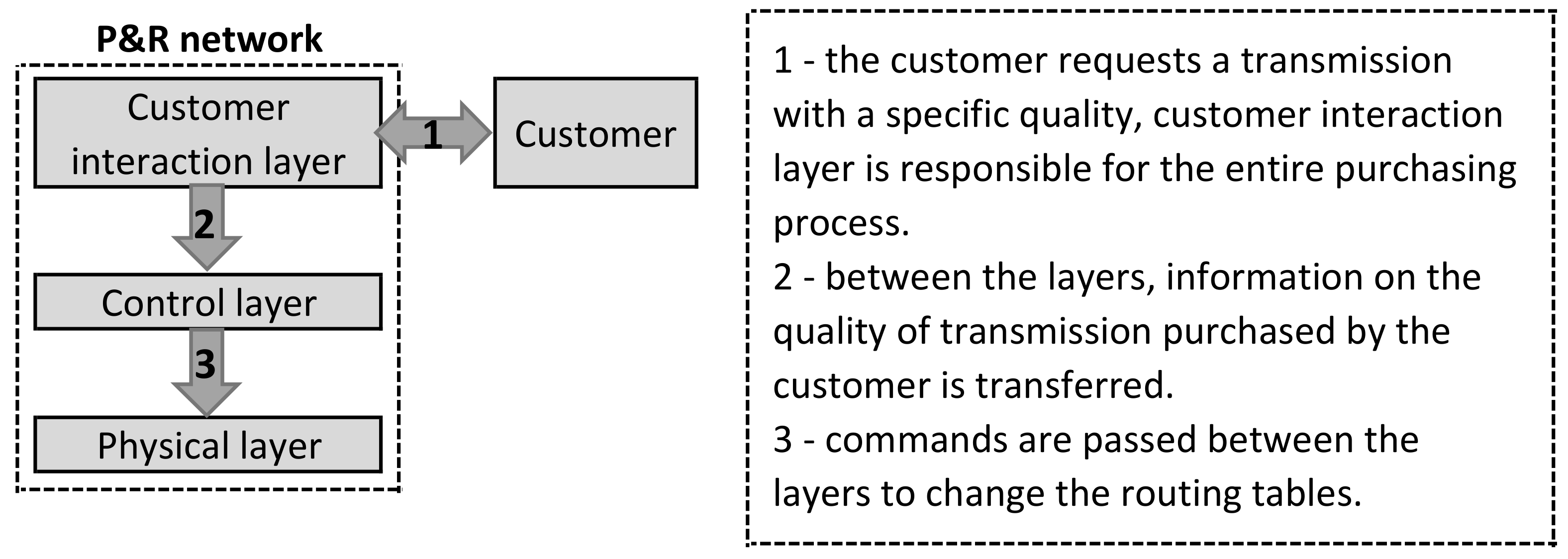
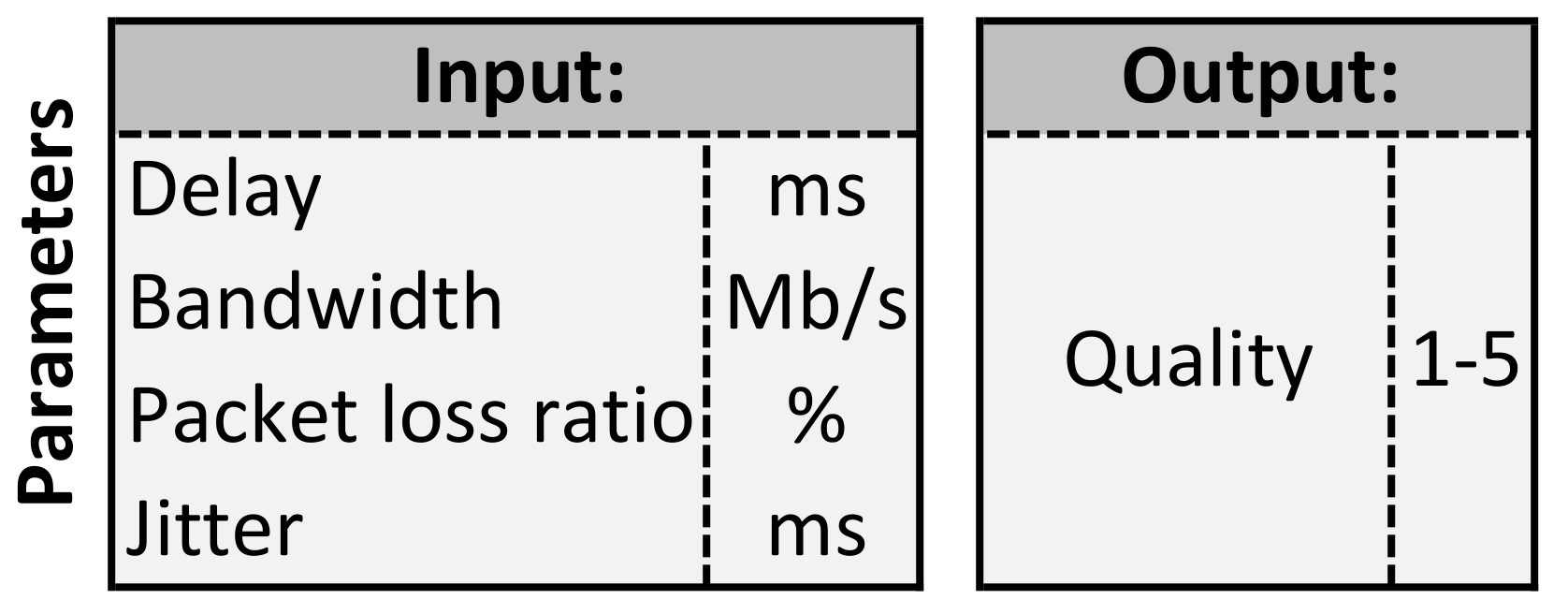
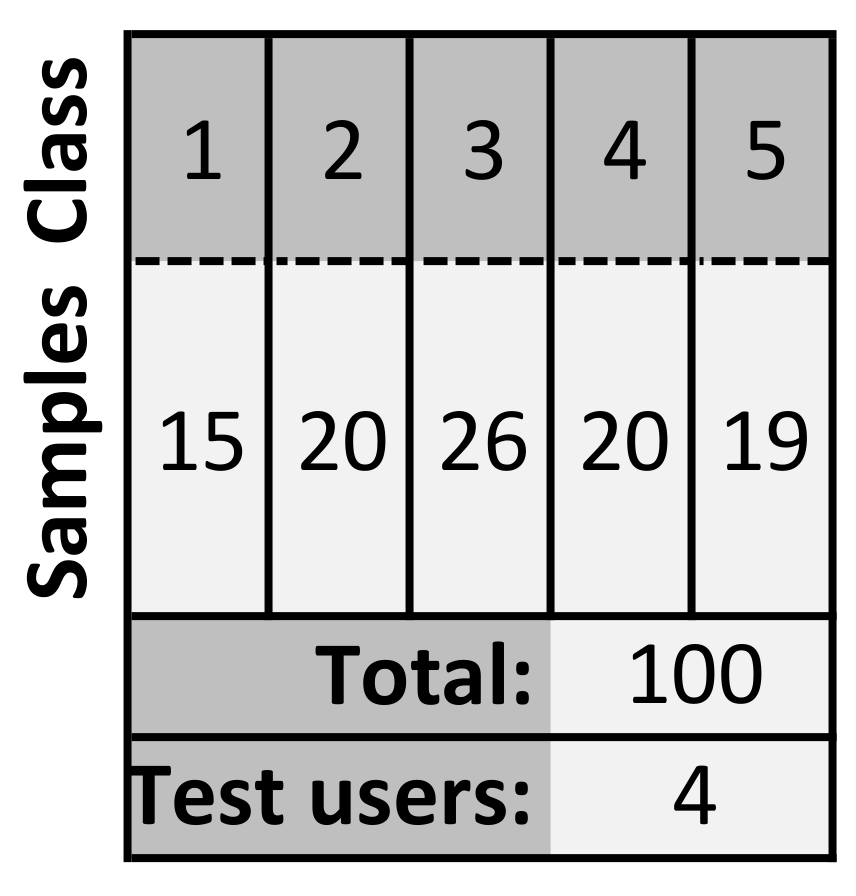
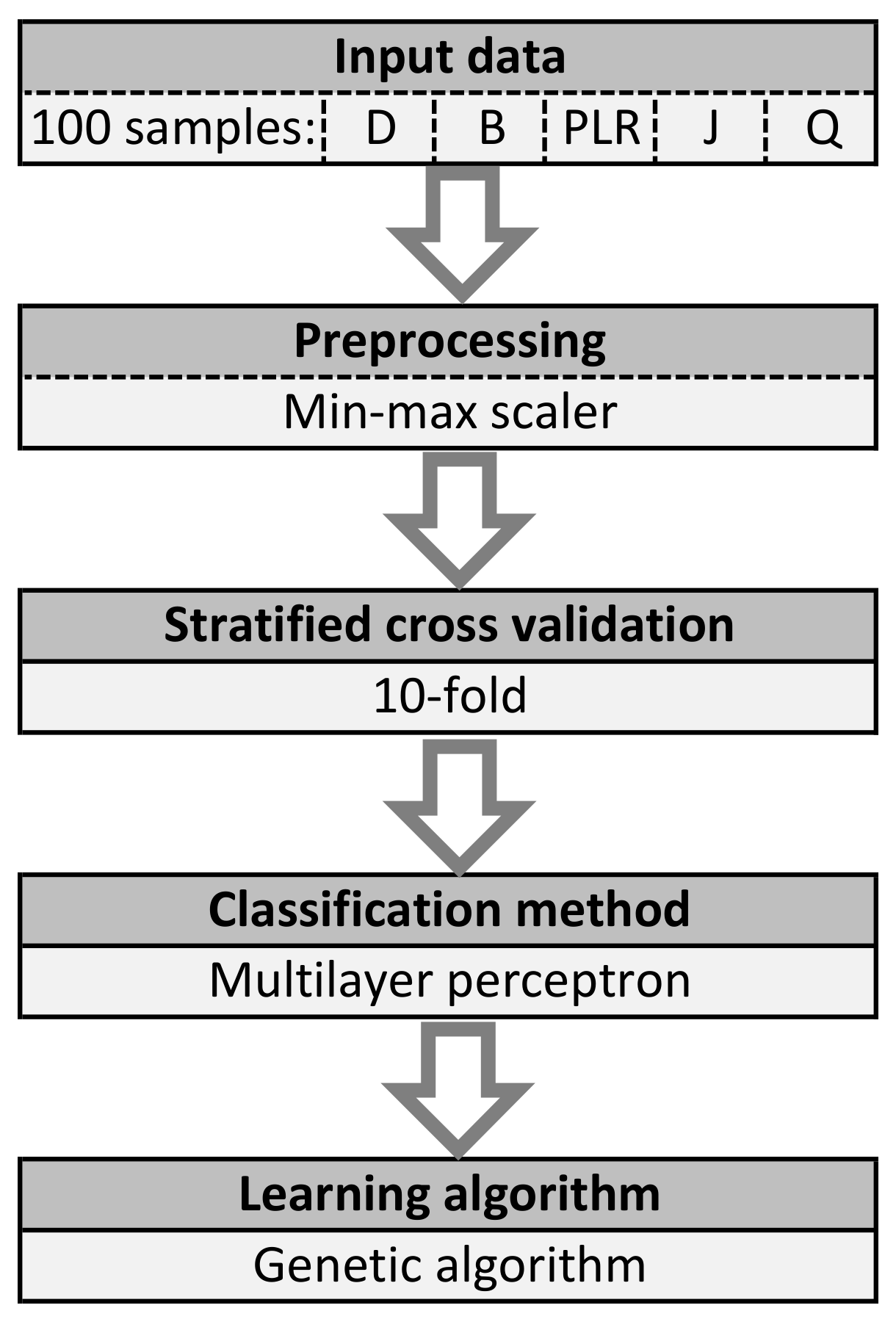

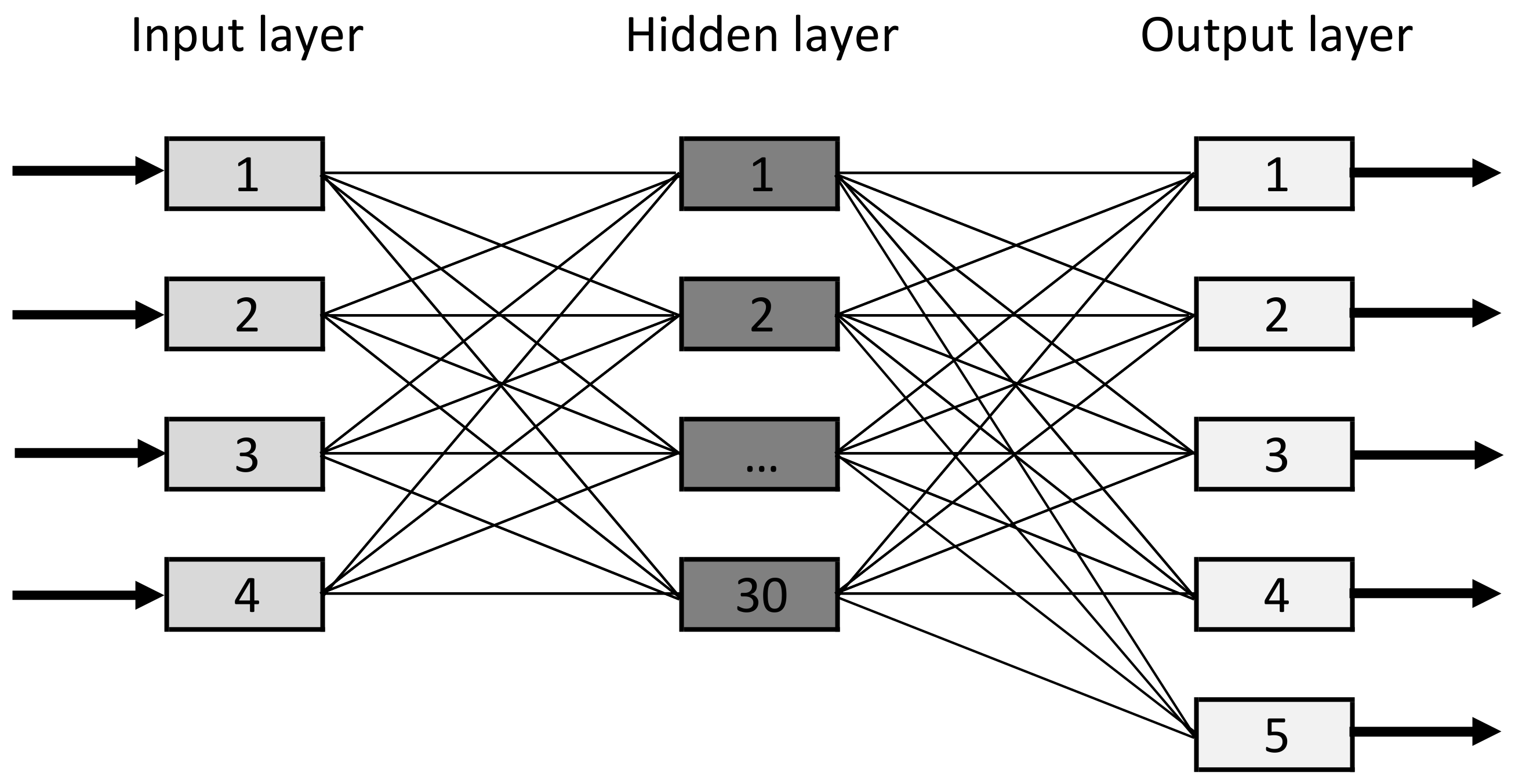

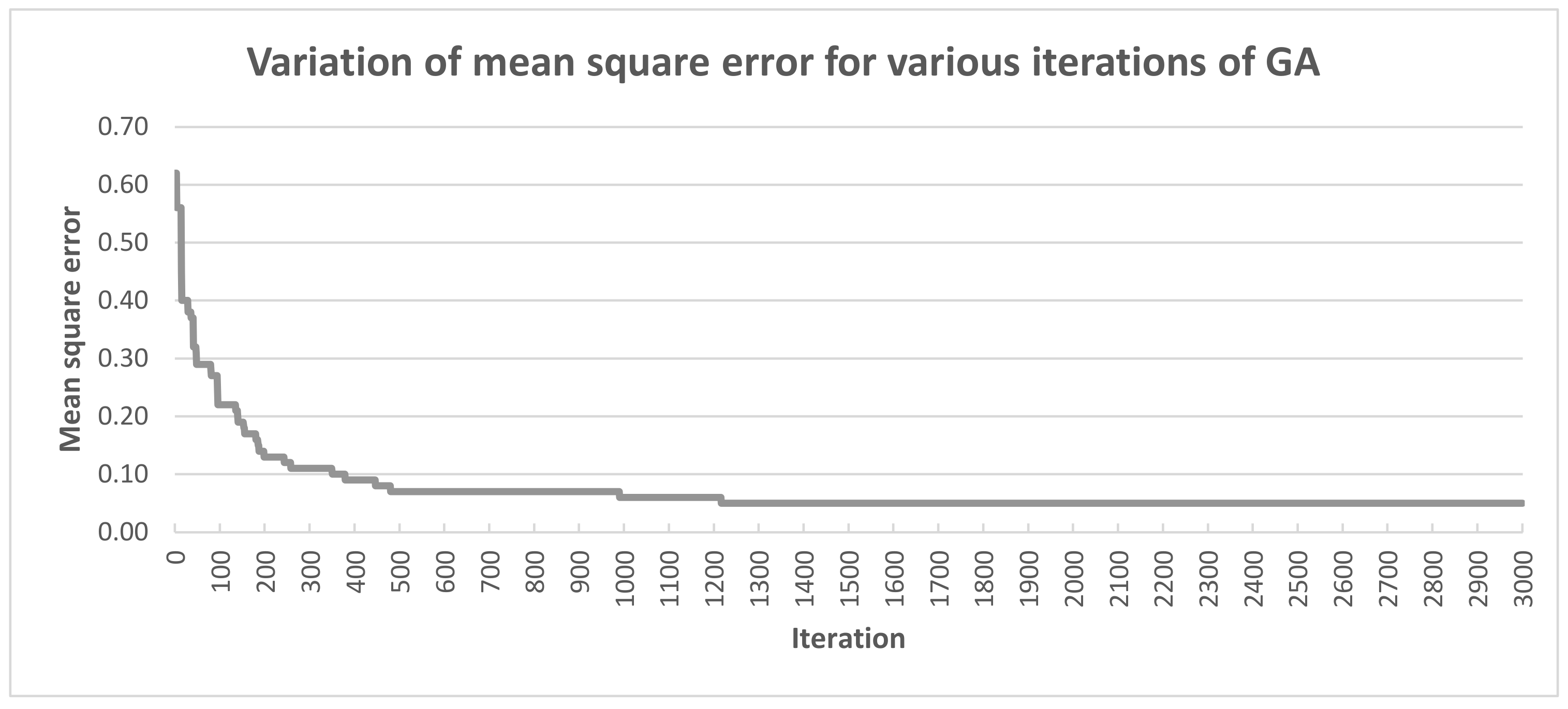
Publisher’s Note: MDPI stays neutral with regard to jurisdictional claims in published maps and institutional affiliations. |
© 2021 by the authors. Licensee MDPI, Basel, Switzerland. This article is an open access article distributed under the terms and conditions of the Creative Commons Attribution (CC BY) license (https://creativecommons.org/licenses/by/4.0/).
Share and Cite
Żelasko, D.; Książek, W.; Pławiak, P. Transmission Quality Classification with Use of Fusion of Neural Network and Genetic Algorithm in Pay&Require Multi-Agent Managed Network. Sensors 2021, 21, 4090. https://doi.org/10.3390/s21124090
Żelasko D, Książek W, Pławiak P. Transmission Quality Classification with Use of Fusion of Neural Network and Genetic Algorithm in Pay&Require Multi-Agent Managed Network. Sensors. 2021; 21(12):4090. https://doi.org/10.3390/s21124090
Chicago/Turabian StyleŻelasko, Dariusz, Wojciech Książek, and Paweł Pławiak. 2021. "Transmission Quality Classification with Use of Fusion of Neural Network and Genetic Algorithm in Pay&Require Multi-Agent Managed Network" Sensors 21, no. 12: 4090. https://doi.org/10.3390/s21124090
APA StyleŻelasko, D., Książek, W., & Pławiak, P. (2021). Transmission Quality Classification with Use of Fusion of Neural Network and Genetic Algorithm in Pay&Require Multi-Agent Managed Network. Sensors, 21(12), 4090. https://doi.org/10.3390/s21124090








